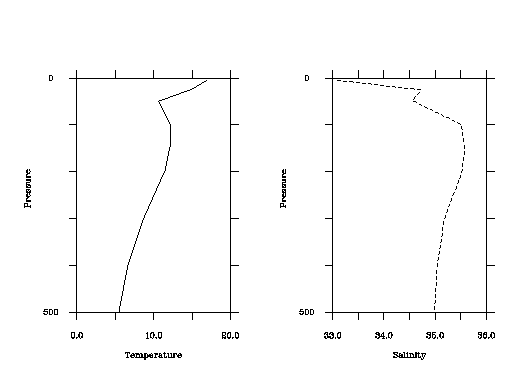User Interfaces
Command Line
After setting one's path appropriately to include the JGOFS binaries,
one can type commands which directly invoke programs that communicate
with the data system. Such commands can also be incorporated in a shell
script (perhaps with arguments) for repetitive operations. The basic
commands are
Listing Data Objects
readdct
Presents the names of the data objects with a brief description.
Listing an Object
listvar "object"
Lists the variables in the object, with indenting indicating the
hierarchical structure.
list "object"
Lists the data
In addition, there are options for other kinds of
listings:
list [-n] [-s] [-t] [-f] [-b] [-c] [-z] object [outfile]
Plotting
p "object" [-r] [-l] xvar [-r] [-l] yvar [-sym ] [+sym ] [-siz ]
[-nobrk] [-brk breakvar]
X-Y plot (autoscaled)
view xv0 yv0 xv1 yv1
Sets position of lower left and upper right corners of plotting area
on the page (0 to 100)
window x0 y0 x1 y1
Sets user units for lower left and upper right corner
axis [-l] x/y tic label num format
Draws axis
pl "object" [-l] xvar [-l] yvar [-sym ] [+sym ] [-siz ]
[-nobrk] [-brk breakvar]
Plots lines, symbols, or connected symbols
dash "object" [-l] xvar [-l] yvar dashpattern
Plots with dashed lines
text "text" x/y/-x/-y size xloc yloc [-u]
Write text on graphics screen
ers
Erase page
ch filename var=value [var=value ...]
Change a file with lines giving values to variables; c.f. plot.var
Example
As an example, consider the following shell script twoplot:
!/bin/csh -f
ers
view 15 20 45 80
window 0 500 20 0
axis x 5 Temperature 10 dd.d
axis y 100 Pressure 500 ddd
pl "/test(station=$1)" temp press
view 65 20 95 80
window 33 500 36 0
axis x 0.5 Salinity 1 dd.d
axis y 100 Pressure 500 ddd
dash "/test(station=$1)" sal press ----....----....
The command
twoplot 6
produces

Menu Interfaces
The menu interfaces provide a means for organizing the commands, showing
information in several windows so that one can keep more than one result
on the screen, and keeping information such as the object name from
command to command. The X version provides a "point and click" kind of
access, but can, in fact also execute typed commands.
Browser Interface
The browser interface can be used from UNIX-X, MS-DOS-Windows, and Mac
machines. You can try it
here. In addition, It is possible to
install software on UNIX machines which allows you to use the local
server and obtain full functionality through browers.

